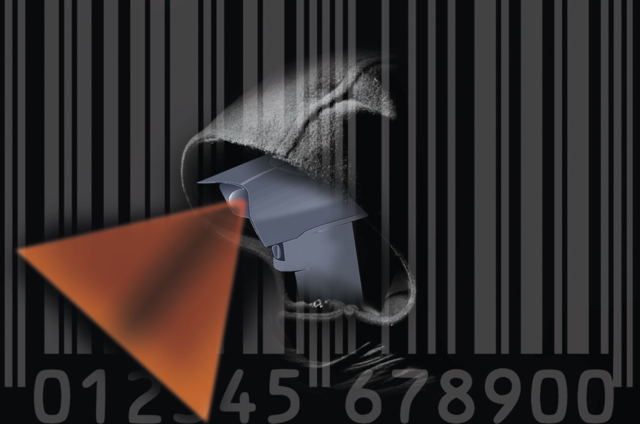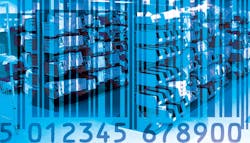For more than 45 years the retail market has relied on bar coding as a staple — and commercially stable — supply chain tracking mechanism with tentacles extended to food service and healthcare operations.
As more advanced techniques and technologies emerged, however, bar coding retained its popularity and solid base in healthcare — some contend for cost purposes, others for familiarity and reliability.
So what is it about bar coding — arguably and metaphorically considered “analog” to the more “digital” offerings of radiofrequency identification (RFID) and others — that cements its stature as the workhorse of people and product tracking?
(Editor’s Note: GS1 US offers a history of bar coding that hearkens back to its debut in 1974. Read about it by visiting: www.gs1us.org/45thanniversary. For Healthcare Purchasing News’ report on RFID, Visit https://hpnonline.com/21092222.)
Against the backdrop of higher-technology RFID and real-time location systems (RTLS), HPN asked eight bar-coding experts — including one retired hospital supply chain executive who is widely regarded as a pioneer in applying bar codes to healthcare provider applications and functions — what motivates the faithful to support it.
Supply chain and beyond
When RFID and other track-and-trace technologies emerged in healthcare roughly 15 years ago, enthusiasts and futurists as well as many curious, foresaw the logical successor to and replacement of bar coding, which at that time had been used for roughly three decades in retail and about two decades in healthcare.
That was then; this is now.
Many bar-code backers and promoters report the “death” of the technology as greatly exaggerated or woefully premature.
“We believe bar coding will become more critical in the healthcare industry as bar-code technology remains the most cost-efficient method used for tracing and tracking,” she told HPN. Lee cites higher demand for patient safety and supply chain efficiency as justifications, buttressed by a variety of federal regulations to protect patient confidentiality and increase visibility and traceability of pharmaceutical products and medical devices, including the Drug Supply Chain Security Act, Unique Device Identification (UDI) and HIPAA (Health Insurance Portability and Accountability Act), with GS1 US at the forefront of supply data standards in multiple industries.
Bar-code labels to identify pharmaceutical products and medical devices and enable tracking of the goods from manufacturing and distribution to use in provider settings, according to Lee. “From safety identification and traceability standpoints, bar codes can minimize counterfeits and fraud while expediting recalls,” she added. “It enables visibility and control of the product throughout the supply chain.”
“As technology and computing power continue to advance, bar codes and other data carriers will also continue to evolve,” O’Bara indicated. “For some applications, the linear bar code is already giving way in the healthcare setting to 2-dimensional, or GS1 DataMatrix, bar codes that can carry more information beyond the product identification number. This transition is now taking place in the pharmaceutical supply chain as trading partners adopt new technologies to meet the requirements of the U.S. FDA’s Drug Supply Chain Security Act (DSCSA). And in the medical device sector, there is movement toward the use of GS1-128 and GS1 DataMatrix bar codes for meeting requirements of the U.S. FDA’s Unique Device Identification (UDI) Rule.” O’Bara noted that some large corporations favor using “the same bar code across their full product portfolio, regardless of packaging size or manufacturing location.”
The variety of available bar code types can apply to whatever information needs to be carried, according to O’Bara.
“Bar codes and the information encoded within are key to patient safety and supply chain traceability,” she continued. “The bar code unlocks detailed product information needed by different stakeholders, including but not limited to the unique product identifier, expiration date, production date, batch/lot number and serial number. Unique identification is fundamental to that data, and because the bar code provides a shareable, standardized gateway to the identifier and associated information, its usefulness will not change.
“At GS1 US, we believe the world is moving toward a future where everything that can be connected will be connected,” she added. “Unique product and location identification are integral in that evolution.”
For example, a 2016 Johns Hopkins study posits that preventable medical errors in a healthcare setting rank as the third leading cause of death in the U.S. so managing and minimizing human errors is critical not only to patient safety, but to the organization’s reputation and credibility. Sullivan emphasizes that bar coding works to solve preventable medical errors.
A 2017 Zebra Technologies video, “Unlocking the Benefits of UDI,” shows that “manually taking down information by hand results in a preventable mistake once every four days in a patient environment,” according to Sullivan. “Bar-coded digitized workflow, on the other hand, has an error rate of about 1 in 10 million, virtually eliminating the threat of human error in recording information. This has created a tremendous difference in the accuracy of the work, from patient admittance to discharge.”
Using bar codes has significantly improved the accuracy, workflow and supply chain management of blood collection, which is a major pain point in healthcare today, Sullivan continued. “Data mistakes in the blood collection process account for a large percentage of errors. Bar-code technology offers a seamless, error-free way to ensure blood is being collected and handled with care,” he added.
Finally, Sullivan posits that supply chain mismanagement leads to millions of dollars lost annually, and that a 2018 Navigant study (https://www.navigant.com/news/corporate-news/2018/supply-chain-analysis-2018) suggests as much as 17 percent of healthcare expenditures are being wasted. “This could be due to expired inventory, products in recall that are still being used, or overages in stock ordering,” he said. “By proactively implementing barcode technology inventory management systems, hospitals are able to more easily optimize the use of their supplies.”
Bar coding represents convenience that generates cost reductions for at least double the philosophical return on investment, according to Kristen Merrell, Vice President, Marketing, Kem Medical Products Corp.
“Rather than the time consuming and laborious tasks of tracking data by hand or by using spreadsheets, as was common practice prior to bar coding, it is easy to scan an item and set in motion a data-rich process that is capable of providing information regarding arrival and delivery confirmations, location tracking, usage history, productivity and quality assurance as well as regulatory compliance,” Merrell noted. “All of this information further assists as a tool for trend predictions and maintenance and staff scheduling.
“Bar coding is an attractive and reliable technology because of its simplicity and adaptability,” she continued. “It is relatively inexpensive to implement, as well as easy to maintain. It also provides a platform that can be adapted for expansion and/or integration into other applications. It is an incredibly flexible technology that allows for near limitless growth.”
“It is unlikely that in healthcare the need for accuracy, efficiency, security, patient safety, cost control, etc., will ever go away,” Kilzer told HPN. “The benefits to using bar codes are well documented and will always drive a need for ongoing use of this technology. Kilzer should know. He spent his entire 43-year healthcare supply chain career at St. Alexius, where he is regarded as one of the first hospital supply chain executives to adopt and implement bar coding at his facility in 1985. He was inducted into Bellwether League’s Hall of Fame for Healthcare Supply Chain Leadership in 2010. (Editor’s Note: For more on Kilzer’s experience with bar coding, read his sidebar below.)
Never say never
“While we can’t say bar coding will never be replaced, there’s really nothing on the horizon that has the potential to replace it,” assured John Freund, President and CEO, Jump Technologies Inc. “I believe bar coding will remain strong because other options are cost prohibitive. Reimbursement rates on med/surg products are low, which makes the cost to invest in alternative technologies like RFID or scales difficult to justify. The lowest cost way to work with med/surg supplies is to use bar codes, whether you’re doing so in a perpetual inventory or KanBan system.”
Jeff Lawrence, Vice President, Business Development, Inventory Optimization Solutions, agrees with that assessment.
For one, bar coding will help organizations manage through regulations, according to Lawrence.
“We’ll always have regulations to comply with and as we need to proactively manage lot number, serial number and/or expiration date, bar-code labels will greatly simplify adherence to these requirements,” he added.
Lawrence hitches a “psychological component” to bar coding’s popularity, too.
“People have come to believe in bar codes and believe bar coding is helping them be more efficient,” he noted. “So do I, by the way. I talk to people in provider organizations every day who say they have a goal to use bar codes toward greater supply chain efficiency, but they don’t yet know exactly how. Tying together that goal with current technology and the data that’s available by capturing bar codes is the grail. The more sophisticated the bar-code data set becomes, and the more efficiently we can capture it, the better the results we’ll see in supply chain and beyond.”
Global endorsements abound
The patient safety promise and labor efficiencies that bar coding brings to hospitals amounts to a tacit endorsement of its utility, emphasizes Zebra’s Sullivan, who uses the retail experience as proof of concept.
“When envisioning the adoption of bar codes in hospitals, an easy comparison is their ubiquity in retail,” he said. “At this point, bar codes and scanners are a staple of the consumer experience and hard to imagine not being present today. To eliminate their use would be a huge step backwards, eroding significant advancements in technology as well as productivity.”
Another endorsement of bar coding comes from governments, global healthcare organizations and standard-setting groups that are all establishing industry guidelines that promote the utilization of bar code and bar code-like technologies in patient care delivery settings, Sullivan maintained. He also cites two cases in point: The United Kingdom’s National Health Service (NHS) has implemented a bar-code scan for patient safety initiative and the U.S. Centers for Medicare & Medicaid Services (CMS) electronic health record meaningful use requirements include bar coding as a core stage two measure.
Bar codes are also being used to help combat major societal epidemics, Sullivan continued. “The Drug Supply Chain Security Act is a federal law designed to help with the safety and management of drugs and helps prevent the use of falsified medicine and opioid abuse by enhancing the identification and traceability of compounded drugs throughout the entire supply chain,” he said. “In addition to drugs, medical device laws have also been implemented to ensure the use of unique identification markers to be able to identify the device through distribution and use and to help prevent patient safety challenges. With the combination of regulations and best practice recommendations, those in the healthcare space can be confident in the future and benefits derived from bar codes.”
No turning back
Jump Tech’s Freund labels bar-code scanning a very simple and mature technology — one that “everyone knows how to use in any industry, as evidenced by the self-checkout lines in most major retailers,” he added.
“In the healthcare industry, bar-code scanning has support from all the major touchpoints in the supply chain, from the supplier to the hospital,” Freund asserted. “It requires a nominal amount of work to maintain and with the right point-of-use system, it is very easy to use with great compliance from staff. Bar-code scanning supports KanBan, perpetual inventory, cycle counting and all other deployed inventory workflows. The hardware costs for bar-code scanning have dropped significantly, and recently we deployed scanners in our customer sites starting at $105.
“With the advent of iOS and Android-based devices, very sophisticated barcode scanning solutions can be deployed at very low costs,” he said. “For example, tracking trunk stock in the OR can be done by manufacturer’s reps scanning GS1 codes on mobile devices during a procedure. Supply chain software can then verify that the item is on contract with the hospital and submit the materials to a circulating nurse for approval. All of this points to bar-code scanning being a solution that has staying power and the ability to provide great benefits to the healthcare industry.”
Bar coding offers a familiar user-friendliness that can be comforting against the backdrop of increasingly complex technology, according to IOS’ Lawrence.
“Bar-code technology is very cost efficient [in that] the equipment isn’t expensive and we’re seeing more organizations using their smartphones to basically create a mobile Materials Management Information System (MMIS),” he observed. “Between the low cost and high efficiency, we’re seeing high growth, especially in non-acute care settings.”
The combination of surgical centers, clinic locations, urgent care centers and other classes of trade that comprise selected organizations are driving fast growth, too, according to Lawrence.
“It’s exciting to see care providers and managers becoming more mobile, moving and managing among locations,” he noted. “The benefit of carrying your ‘MMIS in your pocket’ becomes very powerful. Users can create orders, approve orders, track product consumption, perform physical counts, and more. Within these diverse environments, bar-code scanning drives consistency with processes and tools.”
Even as technology advances, bar coding maintains a way of keeping everyone in the game, Lawrence emphasized.
“Depending on the level of sophistication that a provider has or needs, simply printing internal bar codes that align with the MMIS numbering schema can greatly simplify bar-code scanning processes,” he said. “Overall, because bar coding is so simple, efficient and accurate, as product information tracking becomes more complicated, bar coding is how we’ll keep pace and get more efficient, even while requirements expand.”
Bar coding remains ubiquitous with information technology, GS1 US’ O’Bara noted.
“Behind the bar code is a world of information that will always be necessary — complete, accurate and interoperable information that can be captured and shared electronically — to provide the insights needed to support quality care outcomes and the ultimate goal of patient safety,” O’Bara said. “As a fundamental tool for accessing that data, the bar code has evolved to meet the changing needs of industry, as evidenced by the progression from linear to 2-D bar codes to accommodate the need for more data in smaller spaces.
“Its continued usefulness is driven by industry members’ collaborative efforts through participation in the “GS1 Healthcare US Initiative” (https://www.gs1us.org/industries/healthcare/initiative) to build upon the investment they have already made in utilizing standards for generating and sharing that essential data,” she continued. “The ability to embed critical information within a product’s unique identifier — which can be scanned at each point in the supply chain, including at point of care — is essential to the transformation taking place in healthcare. And the healthcare industry’s ongoing commitment and collaboration with GS1 US helps ensure that the data is optimized to provide the value that is needed.

Tampering with bar codes may be real, but preventable
Not even printed stripes or multidimensional shapes on paper or other material seems to be immune to hackers. Why? The technology used to scan and read them and that is connected to a computer may be the culprit. How does a healthcare organization prepare for and prevent this from happening? Bar-code experts share their recommendations.
“Bar-code scanners function similar to a keyboard with the computer. Therefore, a hacker could potentially infiltrate a system with an Open Windows Run Command. Security software is an important component with any type of bar-code driven technology. Bar-code label forgery is also a very real scam that results in billions of dollars lost in retail sales every year. Forged labels are generated by thieves and attached to store items, allowing thieves to purchase items at a fraction of their actual cost.
“However, in the healthcare industry bar-code label failures are a far more likely occurrence. This can often occur when labels are being utilized in an environment that is incompatible with the labels design. A typical example of bar-code label failure is when ink runs or smears on a label, making it unreadable for the bar-code scanner. Or, in some cases, labels will lose adherence and fall off items. Obviously, scenarios such as these result in loss of valuable time, productivity and resources. Failures are typically due to poor quality label stock and inferior adhesive. In the sterile processing department, for example, labels must be able to withstand extremes, such as heat, steam, chemical detergents, disinfectants and sterilants. Choosing a label that is specifically designed to perform under these conditions is imperative.”
Kristen Merrell, Vice President, Marketing, Kem Medical Products Corp.
“Bar-code tampering is a really important reason to align closely with trusted, select vendors, rather than shopping products for lowest cost across websites. Your trusted vendors put energy and money behind caring for the chain of custody of products that they buy, manage in their warehouse and deliver to you.
“As 3-D bar code use increases, we may also see a reduction in the risk of product tampering, but today it’s really chain of custody that often provides the best protection. As this ‘gray market’ of products continues to emerge — where often authentic products are redirected into unauthorized channels, or counterfeit products are introduced into the supply chain, it becomes a huge challenge to maintain. Counterfeit or mishandled products can be delivered into patient care settings everywhere. Everything we use to deliver care — authentic medical devices, pharma products, consumable items, takes on risk if improperly stored, shipped and handled. As soon as we lose the security of the known channel, we risk losing safety, security and potentially efficacy. Reducing this gray market risk through proper product identification and chain of custody is one of the many keys to patient safety.”
Jeff Lawrence, Vice President, Business Development,
Inventory Optimization Solutions
“There are several solutions addressing this risk. DPM (direct part marking) makes it difficult to modify the code on the part, combining bar coding with other technologies (bar code plus RFID with the same information content), applying more than one code (redundancy), etc. Here the technical creativity applied to the specific application opens up a world of options.”
Alberto Ballestra, Healthcare Industry Marketing Manager, Datalogic Inc.
“The best way to protect the bar-code’s integrity is by investing in the right type of bar-code scanning technology. Zebra Technologies’ healthcare-specific 2-D barcode scanners are equipped with advanced capabilities that improve the speed, accuracy and data integrity of the bar-code label. Software configuration features allow for user-specific customizable security management programming that will make the scanner read the bar code more than once before sending data to the host computer. Scanner configuration also enables intelligent mapping between the bar-code data and the health information system, which helps prevent inappropriate information from coming through and gives users the flexibility to block out unnecessary or erroneous information. For more stringent security protection software features can block the decode or QR codes that contain URL addresses.”
Chris Sullivan, Global Healthcare Practice Leader, Zebra Technologies
“GS1 US works continuously with its healthcare industry members to increase the security of the supply chain. Detecting and preventing the sale of counterfeit products is a complex challenge, but working with trusted partners to share standardized information about products in the supply chain helps.
“Commencing Nov. 27, 2019, the U.S. Drug Supply Chain Security Act (DSCSA) requires wholesale distributors to verify the product identifier of returned products to confirm authenticity before these products can be placed into inventory for resale. The DSCSA defines verification as the process of ‘determining whether the product identifier corresponds to the product identifier assigned to the product by the manufacturer or the repackager.’
“In preparation, pharmaceutical supply chain stakeholders collaborated with GS1 and GS1 US to develop a verification messaging standard to enable system interoperability. Ensuring the safety of products in the supply chain, both in sales and returns, allows for the verification of product identifiers for serialized pharmaceutical products. The ‘GS1 Lightweight Messaging Standard for Verification of Product Identifiers (https://www.gs1.org/verification-messaging) is intended to provide a simple, standardized lightweight messaging framework for asking verification questions and receiving actionable information. This messaging standard and guidance was developed with the Healthcare Distribution Alliance (HDA) Verification Routing Services (VRS) Taskforce and is another tool for verifying authenticity of a product identifier and the bar code that contains it.”
Siobhan O’Bara, Senior Vice President, Industry Engagement & Services,
GS1 US
“To protect from maliciously altered or tampered bar codes it is important for organizations to implement only the bar codes that were developed by the two standards organizations, GS1 and HIBCC. Although there is always a risk that alteration occurred, there are safety features built into the standards to minimize this risk. Having a communication channel with representatives from these organizations would be helpful in understanding how these safety features minimize the potential for alteration or tampering.”
Frank Kilzer, retired Vice President, Material and Facility Resources,
St. Alexius Medical Center, Bismarck, ND
Bar coding’s multi-dimensional expanse
That swath of vertically oriented stripes may be the granddaddy of bar codes, but the second- and third-generation “descendants” expand the utility and utilization of bar-code technology, enabling suppliers and providers to pack more useful data into a small space for track-and-trace purposes.
Siobhan O’Bara, Senior Vice President, Industry Engagement & Services, GS1 US, stresses that the primary focus of any decision must always be the patient.
“To that end, they are focused on connecting supply chain information to track, trace and verify products through their unique identifiers from the point of manufacture to the point of care, which includes meeting the requirements of the DSCSA, the UDI Rule and Meaningful Use Stage 3,” O’Bara explained. “At the same time, they are running a business, so they must do everything they can to minimize risk and optimize process flows for functional and financial benefit in support of patient care.
“The most common uses of unique product identification in healthcare today are to enable traceability supporting the industry’s ability to protect patients’ five rights of medication (the right patient, the right drug, the right dose, the right route, and the right time),” she continued. “It enables the same type of inventory control and traceability for medical devices, in support of the UDI Rule. And it is instrumental in improving the patient experience by enabling data to be captured at the point of care with a simple scan. Patient safety is enhanced by the ability to upload drug and device identifiers directly into the patient’s electronic health record (EHR).
Using GS1 Standards-based bar codes in healthcare helps enable the following, according to O’Bara:
- Unique device identification in support of the U.S. FDA UDI Rule — making sure the right medical device is available when it is needed and can be tracked throughout its life cycle
- Serialized product information in support of the DSCSA — ensuring the five rights of medication, so patients receive the proper medication
- Accurate patient records — capturing unique identifiers for drugs and medical implants and importing the data to patients’ EHRs for reference in their ongoing care, enabling providers to easily access the information and use it to correlate and understand outcomes in context
- Improved inventory management — knowing where a product is at any time or location within its supply chain, ensuring that it is available when and where it is needed, and enabling faster, more efficient and accurate returns in the event of a recall
- Verification of returns — ensuring authenticity of products for rebate or resale, if eligible.
“Bar codes … are especially important when dealing with any critical care patient situations as economic and safety threats are more intense, and mistakes can be more costly than in other industries,” said Chris Sullivan, Global Healthcare Practice Leader, Zebra Technologies. Key [industry] challenges and use cases for bar codes include, but are not limited to the following:
- Registration and Admission: Barcodes can accurately identify patients for billing and reimbursement. Individuals can have the same name leading to mistakes that could result in financial distress for both the patient and healthcare organization.
- Medication Administration: Bar code-based systems help reduce patient care delivery identity mistakes associated with the patient, the drug, the dosage level, the drug route, and the time of delivery.
- Blood Collection: Daily blood draws are routine and with so many different samples floating around, clear labeling is essential to ensure the blood specimen not only makes it to the lab, but that the patient and care team receive the correct results.
- Blood Transfusion Management: Blood transfusions are a critical lifesaving component requiring extreme care to both the blood and patient. Barcode technology can reduce human error associated with transfusions and ensure that the right blood type is matched to the right patient.
- Medical Device Supply Chain Tracking: Serialized bar codes facilitate track and track capabilities on medical devices and can prevent unsafe products from being administered to patients.
- Mother-Infant Breast Milk: Through the use of bar codes an accurate matching of the mother’s breast milk to their infant child is more easily administered and identity mistakes are reduced.
“From a financial and operational standpoint bar-code label technology makes sense in all areas of the healthcare industry,” said Kristen Merrell, Vice President, Marketing, Kem Medical Products Corp. “The applications for the usage of bar-code tracking technology are limitless. The beauty of bar-code tracking is the simplicity. The amount of data that can be generated and utilized for a multitude of purposes is only dependent upon the end user’s imagination. Virtually anything and everything can be tracked. The more information that is entered into the database combined with the amount of tracking locations, as well as defined tasks, allow for the opportunity to create a customized approach for tracking assets and productivity. Specifically, with regards to productivity, barcoding greatly reduces human errors and greatly increases productivity.”
Bar-coding experts acknowledge that first-generation, one-dimensional (1-D) models remain the oldest and most widely used form in multiple industries and markets, but the newer 2-D and 3-D options offer a bit more byte for the investment. Here’s what bar-coding experts say about the areas — people, products and equipment — that make the most financial and operational sense for the three bar coding models to be applied.
1-D
“1-D bar codes are the most prevalent in the industry and require the lowest-cost hardware for use. They are most commonly used for shelf labels or labels on bins used in KanBan systems. Most UPC codes found on product packaging are 1-D codes as well.”
John Freund, President and CEO, Jump Technologies Inc.
“Some applications can still call for 1-D barcodes, especially if a small amount of information is needed (maximum 20 -25 characters). The Codabar (1-D) is still used at blood banks, on wristbands and for medical records. 1-D bar codes depend on the capability to be located within a database to be useful. In some applications — such as wristbands — both 1-D and 2-D bar codes are used in conjunction with each other.”
Theresa Lee, Product Manager, Toshiba America Business Solutions
“The GS1 standard of GTIN is being implemented by manufacturers on most products used in acute and non-acute care settings. We often see GTIN in 1-D bar codes that are good for single identifiers, like the GTIN or a specific location. Good scanning capability is immediately important — the length of the GTIN and font size makes capturing them without good scanning technology tricky. Soon we’ll only be able to employ people under 25 years old that can actually read product information. Kidding aside, bar-code scanning is the only way to manage the accuracy needed with tracking GTINs and related information.”
Jeff Lawrence, Vice President, Business Development, Inventory Optimization Solutions
“Patient positive identification.”
Alberto Ballestra, Healthcare Industry Marketing Manager, Datalogic Inc.
“1-D barcodes are no longer adequate for healthcare settings.”
Chris Sullivan, Global Healthcare Practice Leader, Zebra Technologies
2-D
“2-D bar codes are used when you have a lot of information to record with a scan, but not a lot of room for the bar code itself. GS1 codes can be either 1-D or 2-D; however, 2-D takes up the least amount of room on packaging and, therefore is a great way to record lot, serial number, and expiration information for a given item. Product packaging for implantable medical devices often uses 2-D bar codes.”
John Freund, President and CEO, Jump Technologies Inc.
“2-D bar codes are increasing in use for their capability of including more information (maximum 2,000 characters). Beyond the name of the products/goods, you may include additional detail, such as the expiration date and batch number.
“For UDI, a consideration is that [because] some of the medical device’s footprints are small and a large amount of information is mandatory by the FDA, a medical device vendor must use 2-D bar codes. The 2-D barcode is more flexible because it encodes alphanumeric information. It can contain images, voice, website addresses and other types of binary data. That means you can make use of the information without a database connection.”
Theresa Lee, Product Manager, Toshiba America Business Solutions
“Today we’re seeing far more use of 2-D bar codes because they hold multiple data attributes. We see providers using 2-D bar codes to scan and capture a supply location, a product, specific attributes of that product, even a department, so they automatically know where they were scanning items — from pre-op, to the OR, or the PACU — and what areas and items need replenishment. The person doing the scanning doesn’t need to be an expert on processes and locations because the data contained in the 2-D bar code captures all that data for them. We’ve also recently seen an increase in using 2-D for two-bin inventory, where the quantity for each bin of items is contained in the bar code, along with all the other relevant data.”
Jeff Lawrence, Vice President, Business Development, Inventory Optimization Solutions
“Unique device identification (UDI).”
Alberto Ballestra, Healthcare Industry Marketing Manager, Datalogic Inc.
“2-D bar codes are capable of handling the intensity and complexity of healthcare data.
Chris Sullivan, Global Healthcare Practice Leader, Zebra Technologies
3-D
“3-D bar codes store even more information. QR codes are a common example of this. 3-D bar-code scanning can be used for tracking assets and related information like purchase date, warranty date, service date, serial number and the like. This type of bar coding is also good for tracking patient information like name, procedure, procedure date, doctor and room for scheduled surgeries.”
John Freund, President and CEO, Jump Technologies Inc.
“The 3-D bar code is the most permanent type of bar code, and most often used to engrave and emboss an alloy onto the product. 3-D barcodes are ideal for devices that endure high pressure and heat within the manufacturing process. Many permanent medical devices require the use of 3-D bar-code labels.”
Theresa Lee, Product Manager, Toshiba America Business Solutions
“Pharma packaging identification.
Alberto Ballestra, Healthcare Industry Marketing Manager, Datalogic Inc.
“3-D bar codes are typically used for direct part marking applications with surgical instruments and other reusable pieces of equipment.”
Chris Sullivan, Global Healthcare Practice Leader, Zebra Technologies
Retired healthcare bar-coding pioneer reflects on stripes earned for the cause
by Rick Dana Barlow
 Frank KilzerFrank Kilzer knows a little something about using bar codes in a hospital supply chain management department. After all, bar coding represented a significant portion of his life’s work.
Frank KilzerFrank Kilzer knows a little something about using bar codes in a hospital supply chain management department. After all, bar coding represented a significant portion of his life’s work.
During his 43-year career, in which he spent much of it promoting the benefits of using bar codes, Kilzer recalls working closely with organizations such as GS1 and HIBCC to promote standards. He estimates he participated in more than 200 educational conferences in 43 of the largest cities in 23 states from coast to coast and at numerous conferences in 12 cities in nine foreign countries. He visited more than 500 hospitals and clinics around the globe to help them implement bar codes within their organizations.
For Kilzer, retired Vice President, Material and Facility Resources, St. Alexius Medical Center, Bismarck, ND, his mission and passion for providers to use bar codes emerged 34 years ago within his own facility. To some extent, he felt that he and his team were on their own.
“When we implemented bar coding in 1985 the [hospital’s] Materials Management Information Systems did not have the ability to handle bar-code technology, and at the time manufacturers were not printing bar codes on medical products sold to providers,” Kilzer told Healthcare Purchasing News from his home in Montana. “We exhausted every source we had with no success finding another provider that was already using bar codes. We were hoping we could learn how to start but with no other providers doing this we developed a bar-code system using our proprietary numbers.
“I recall asking a [Johnson & Johnson] representative to put bar codes on their products, and after researching the idea he responded that it would cost over $19 million dollars to re-label their product packaging, which he said would then require them to re-file for FDA approval due to the changes with the packaging label,” Kilzer continued. “He asked who would pay for it, and my response was the savings would be so significant to offset the expense that providers would be willing to absorb the cost.”
But within a decade the company came around.
“Surprising to us, it was the J&J Ethicon Division to be the first manufacturer we encountered to bar code all of their suture boxes,” he recalled. “We immediately (in 1994) updated our MMIS to use both our proprietary numbering system and incorporate their bar codes into our MMIS. This enabled us to receive their sutures by scanning the boxes, same as retailers do today at the checkout counter, except we were checking products into our system and our efficiencies continued to grow. Later on, I don’t recall the exact date, we read a journal article about Thomas Jefferson University having implemented bar coding. We toured their facility and learned they were having similar success. Their focus was on pharmacy, and in the early phases of what we were already doing.”
In those early stages of bar code adoption and implementation, providers encountered hurdles to overcome, according to Kilzer. “The question as to whether there would be two standards, GS1 and HIBCC, or would the industry consolidate to one standard generated a lot of discussion and indecision,” he remembered. “When I was asked the question about which one to choose my response was ‘just pick one and get started!’ Eventually the manufacturers started labeling their products with either of the two standards, and we began to hear about other hospitals adopting capabilities for scanning.”
Kilzer, who was inducted into Bellwether League’s Hall of Fame for Healthcare Supply Chain Leadership in 2010, was “instrumental in establishing industry wide acceptance of the Universal Product Number (UPN), including a unique number for each packaging level,” according to his Bellwether League biographical profile. “He coordinated a Health Industry Business Communications Council (HIBCC) pilot project at St. Alexius Medical Center to research the benefits of scanning bar codes on supplies and pharmaceuticals at the patient bedside. He also assisted the GS1 USA with a demonstration project and successfully tested scanning Reduced Space Symbology (RSS) bar codes at the patient bedside.”
When Kilzer spotted bar coding being used in grocery stores in the mid-1970s, he thought of his hospital’s off-site warehouse and his own supply chain challenges. Roughly 10 years later he earned the C-suite’s nod to purchase a “bleeding edge” bar-coding system and struggled for two years to make it work for the organization, according to his Hall of Fame profile. So Kilzer turned to his hospital’s information technology department to design something internally to kickstart the process into high gear.

Rick Dana Barlow | Senior Editor
Rick Dana Barlow is Senior Editor for Healthcare Purchasing News, an Endeavor Business Media publication. He can be reached at [email protected].












